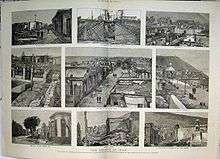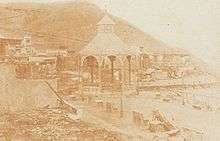Occupation of Lima
The Occupation of Lima by the Chilean Army was an event that happened during the War of the Pacific between 1881 and 1883.
Lima was defended by the remnants of the Peruvian army and crowds of civilians in the lines of San Juan and Miraflores. As the invading army advanced, the towns of Chorrillos and Barranco were occupied on January 13 of the same year while the town of Miraflores was captured on the 16 of January, after the Battle of Miraflores;[1] finally the city of Lima was occupied on January 17.
Developments


In January 1881, Chile controlled the sea along the coasts of Peru, as well as the provinces of Tacna, Arica and Tarapacá. The Chilean troops disembarked in the Peruvian towns of Pisco and Chilca, located to the south of Lima. General Manuel Baquedano was in control of the army of Chile during the Lima campaign.
Lima was going to be defended at first by the remaining Peruvian army and by a vast number of civilians in the line of San Juan - Chorrillos; the American engineer Paul Boyton narrates that " the troops were of natives who had been recruited in the mountain ranges and forced to fight, hundreds of them never had seen before a city ". On the other hand, the strategic line of Miraflores was defended by more troops than civilians.
Nonetheless, and with little effective Peruvian central government remaining, Chile pursued an ambitious campaign throughout Peru, especially along the coast and in the central Sierra, penetrating as far north as Cajamarca, seeking to eliminate any source of resistance.
Liberation of Chinese slaves, disorder and looting
.jpg)
As the war progressed in Chile's advantage, the Chilean Army liberated thousands of Chinese coolies who had been enslaved; for more info see Huanillos "Chinese slaves were very common in that time because in 1850 the Peruvian government made a trade agreement with China; the Peruvian government would give 50 soles per Chinese who worked in the different industries of the time. However the Chinese people, especially men, were treated so badly that a large number of them committed suicide and the few who survived were rescued by Patricio Lynch, a Chilean military officer who fought in The Pacific War."
Liberated Chinese served as helpers with the Chilean army and even formed a regiment under the command of Patricio Lynch, whom the Chinese named 'the red prince'.
Many Chinese saw the Chilean liberation as an opportunity to avenge years of abuse from the plantation owners; in Pacasmayo 600 to 800 Chinese forced labourers looted the sugar estates and this scene was repeated in the Chicama, Lambayeque and Cañete Valleys. The Chinese also fought alongside the Chileans in the battles of San Juan-Chorrillos and Miraflores, and there was also rioting and looting by non-Chinese workers in the coastal cities. As Heraclio Bonilla has observed; oligarchs soon came to fear the popular clashes more than the Chileans, and this was an important reason why they sued for peace. [Source: "From chattel slaves to wage slaves: dynamics of labour bargaining in the Americas", by Mary Turner.]
Prior to the enslavement of Chinese, the Peruvian government carried out the genocide-like Peruvian slave raids in Easter Island.
Prior to the occupation of Lima there were fires and sackings by demoralized Peruvian soldiers in the towns of Chorrillos and Barranco; as quoted by Charles de Varigny, "The [Peruvian] soldiers sacked the city the night of the 16th, the fire lighted her sinisterly and fear reigned among her."
During the occupation of Lima, Chilean military authorities pillaged Peruvian public buildings, turned the old University of San Marcos and the recently inaugurated Palacio de la Exposición into a barracks, raided medical schools and other institutions of education, and carried away a series of monuments and artwork that had adorned the city.[2]
The Chilean army plundered the contents of the Peruvian National Library in Lima and transported thousands of books (including many centuries-old original Spanish, Peruvian and Colonial volumes) to Santiago de Chile, along with much capital stock. When Ricardo Palma was appointed Director of the National Library after the occupation he found that only 378 of its 56,000 books were left.[3] In November 2007, the Chilean government returned 3,778 books to the National Library of Peru.[4]
Scuttling of the Peruvian fleet in El Callao
Resistance
The Peruvian resistance continued for three more years. The leader of the resistance was General Andrés Cáceres (nicknamed the Warlock of the Andes), who would later be elected president of Peru. Under his leadership, the Peruvian militia forces heightened with Indian montoneras inflicted several painful blows upon the Chilean army in small battles such as Marcavalle, Concepción and San Pablo, forcing Colonel Estanislao del Canto's division to return to Lima in 1882. However, Caceres was conclusively defeated by Colonel Alejandro Gorostiaga at Huamachuco on July 10, 1883. After this battle, there was little further resistance. Finally, on 20 October 1883, Peru and Chile signed the Treaty of Ancón, by which Peru's Tarapacá province was ceded to the victor; on its part, Bolivia was forced to cede Antofagasta.
Impact in Chile
After the occupation of Lima Chile diverted part of its war efforts to crush Mapuche resistance in the south.[5] Chilean troops coming from Peru entered Araucanía where they in 1881 defeated the last major Mapuche uprising.[6][7]
After the occupation of Lima was accomplished Chilean newspapers published extremely patriotic, chauvinist and expansionistic material.[6] An extreme example of this journalism is Revista del Sur that wrote that firearms obtained in Peru, while useless in the hands of Peruvian "fags" (Spanish: maricas), would be useful by Chileans to "kill indians" (Mapuches).[6]
References
- ↑ The humiliation of Peru; The battles which preceded the occupation of Lima
- ↑ Hugh Chisholm. "Lima". Encyclopædia Britannica. Retrieved 2008-12-04.
- ↑ James Higgins Lima: a Cultural History page 107
- ↑ Dan Collyns (2007-11-07). "Chile returns looted Peru books". BBC. Retrieved 2007-11-10.
- ↑ Velázquez Elizararrás, Juan Carlos (2007), "El problema de los estados mediterráneos o sin litoral en el derecho internacional marítimo. Un estudio de caso: El diferendo Bolivia-Perú-Chile", Anuario Mexicano de Derecho Internacional, 7: 1379–430
- 1 2 3 Bengoa, José (2000). Historia del pueblo mapuche: Siglos XIX y XX (Seventh ed.). LOM Ediciones. pp. 282–283. ISBN 956-282-232-X.
- ↑ "Ocupación de la Araucanía: Últimas campañas de ocupación", Memoria chilena, retrieved June 30, 2013